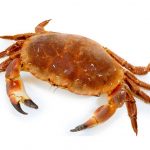 The Latin word for crab, cancer, was borrowed in the early seventeenth century as the name of a malignant disease that creeps like a crab through its victim. Cancer is not, however, the source of the English crab. Instead, the English name of this crustacean, first recorded about a thousand years ago, derives from an unknown Germanic source, one that is probably also the source of the word crawl. Crab the crustacean may in turn be the source of crab the apple: the tart flavour of that fruit may have reminded people, back in the fifteenth century when this sense of crab first appeared, of the “sour” and “biting” temperament of the sea-creature. Alternatively, crab the apple may derive from the Swedish skrabba, meaning wild apple.
The Latin word for crab, cancer, was borrowed in the early seventeenth century as the name of a malignant disease that creeps like a crab through its victim. Cancer is not, however, the source of the English crab. Instead, the English name of this crustacean, first recorded about a thousand years ago, derives from an unknown Germanic source, one that is probably also the source of the word crawl. Crab the crustacean may in turn be the source of crab the apple: the tart flavour of that fruit may have reminded people, back in the fifteenth century when this sense of crab first appeared, of the “sour” and “biting” temperament of the sea-creature. Alternatively, crab the apple may derive from the Swedish skrabba, meaning wild apple.
A louse, Phthirius pubis, which infests the pubic region and other parts of the body with coarse hair.
A thin break.
The crustacean in question possesses a stout and extensive protective exoskeleton, six articulated limbs, and a pair of formidable chelae that resemble threatening pincers. Additionally, the creature boasts succulent, delectable, and pale flesh that is highly regarded for its taste.
There are many delicious species of crab found in the United States. Some of the most notable varieties include Alaska king crab and Dungeness crab from the West coast, and blue crab and stone crab (found in Florida) from the East coast. During the summer, blue crab is also sold as “soft shell crab” when it sheds its shell.
